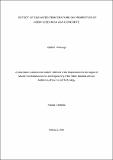| dc.contributor.author | Sufiani, Omari | |
| dc.date.accessioned | 2020-10-09T12:22:03Z | |
| dc.date.available | 2020-10-09T12:22:03Z | |
| dc.date.issued | 2020-05 | |
| dc.identifier.uri | https://doi.org/10.58694/20.500.12479/974 | |
| dc.description | A Dissertation Submitted in Partial Fulfillment of the Requirements for the Degree of
Master’s in Materials Science and Engineering at Nelson Mandela African Institution of
Science and Technology | en_US |
| dc.description.abstract | The deionized (DI) water of high purity standards is used in several industrial processes to
manufacture products and technologies for high end applications. Deionized water is used in
industrial processes such as to manufacture semiconductor and pharmaceuticals among
others. Therefore, it is of significant importance to develop the cost effective technologies to
provide DI water given the tremendous growth of industrial and manufacturing processes.
This study investigated production of deionized water by capacitive deionization (CDI) using
nitric acid treated activated carbon (NTAC) electrodes. Activated carbon (AC) was etched in
nitric acid solution to introduce oxygen functional groups on its surface. The electrochemical
measurements and N2 adsorption-desorption isotherms were used to study the
electrochemical performances and textural properties of the materials respectively. The
Fourier transform infrared spectroscopy and X-ray photoelectron spectroscopy were used to
confirm the surface oxygen containing groups presented by nitric acid treatment. Then AC,
symmetric NTAC, and asymmetric CDI electrode cells were constructed to compare their
performance to produce DI water. It was shown that the treatment of the AC with nitric acid
increased the percentage of oxygen containing functional groups from 12.6 to 17.8 that
enhanced its salt adsorption capacity. As a result the asymmetric electrode cell produced DI
water with 1.6 μS/cm (grade III deionized water, according to International Standard
Organization) starting with water solution of 12.0 μS/cm. Electrochemical impedance
spectroscopy tests revealed good capacitive behavior due to improved conductivity with
NTAC having a series resistance of 0.51 Ω much lower than AC achieved 2.0 Ω. Also NTAC
exhibits highest specific capacitance of 381.7 F/g compared to 106.6 F/g of untreated AC
electrode. Based on the experimental results NTAC is proposed as a potential electrode
material for CDI applications.
Keywords: Capacitive deionization; CDI; deionized water; activated carbon; enhanced
electrosorption; oxygen functional groups. | en_US |
| dc.language.iso | en | en_US |
| dc.publisher | NM-AIST | en_US |
| dc.rights | Attribution-NonCommercial-ShareAlike 4.0 International | * |
| dc.rights | Attribution-NonCommercial-ShareAlike 4.0 International | * |
| dc.rights.uri | http://creativecommons.org/licenses/by-nc-sa/4.0/ | * |
| dc.title | Charge enhanced capacitive deionization electrodes for deionized water production | en_US |
| dc.type | Thesis | en_US |


